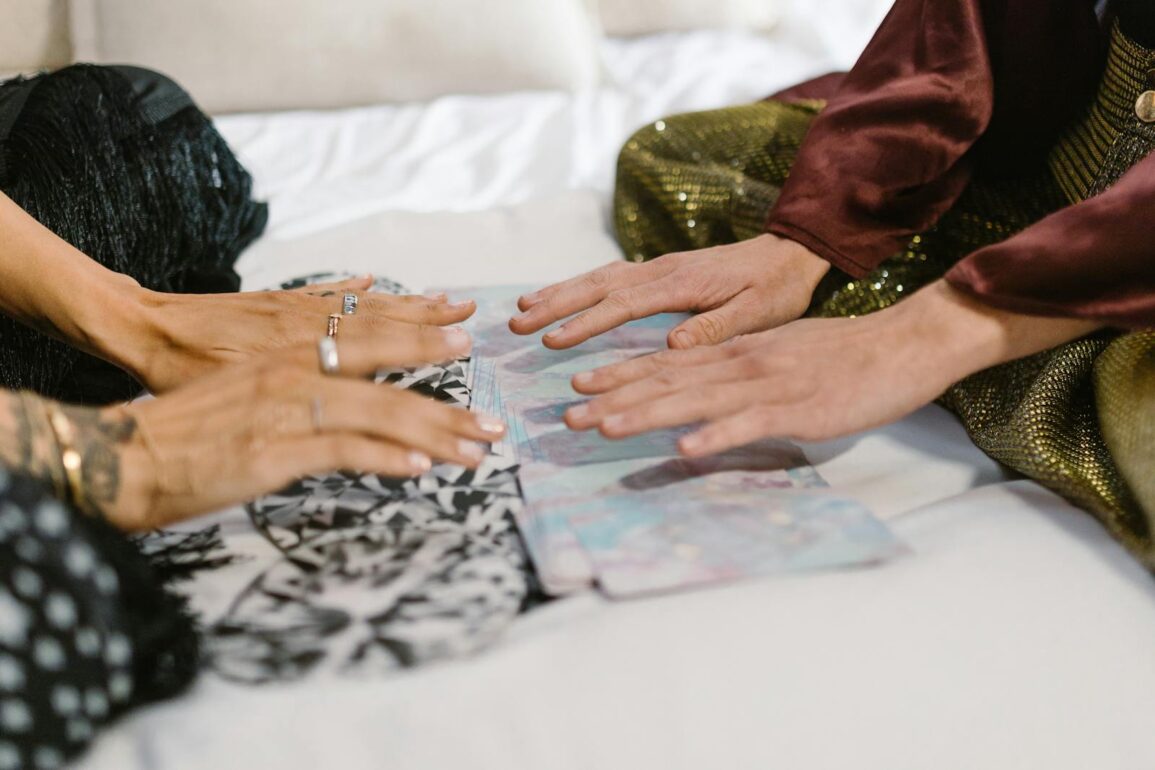Spiritual practices can feel like smoke slipping through your fingers—beautiful but impossible to hold.
After years of watching clients repeat the same cycle of trying meditation apps, lighting sage, and still feeling hollow, I realized the problem wasn’t the tools.
It was the missing structure.
I’ll tell you about one woman whose dusty tarot deck finally spoke to her once she paired it with a tiny daily ritual.
That story still gives me chills.
For now, here’s a grounding start for those who want to explore core practices.
Top Takeaways
Before we go deeper, here are five surprising truths you’ll remember long after reading.
- Daily ritual scaffolding: Structure turns intuitive rituals, tarot spreads, and numerology checks into reliable decisions.
- Symbolic duet: Tarot imagery plus number symbolism amplifies clarity faster than reading either system alone.
- Pattern-backed intuition: Psychology shows pattern recognition; cultural rituals like lunar rituals prime trustworthy gut signals.
- My personal take: Trust grows like training wheels; small daily practice steadies balance before speed.
- Simplify to sharpen: Cut tool overload; journal one card, notice synchronicities, and let divination practices breathe.
“We don’t see magic until we build structure.” Rituals that make intuition real
Rituals make intuition feel real by turning fleeting moments into patterns your body and mind can recognize.
“Discipline is the bridge between goals and accomplishment.” — Jim Rohn
I’ve seen women sit at kitchen tables with tarot cards scattered like laundry, waiting for insight to land. Even the most basic love tarot card meanings can startle with precision once structure is in place.
No structure, just hope.
But the truth? Intuition doesn’t bloom in chaos.
It sharpens when you anchor it with repetition.
Think of it like training your ear to catch subtle notes in music.
A five-minute tarot pull at sunrise, a nightly numerology reflection, or even a simple lunar ritual can tune your intuition the same way.
The outer calm of candlelight often contrasts with the inner storm you’re trying to decode, and that contrast is the point.
When one client finally committed to jotting down her card pulls every morning, the silence stopped feeling empty.
Patterns emerged, her inner voice grew louder, and she began to trust herself more than any horoscope headline.
Key Takeaway: Rituals provide scaffolding so intuition stops floating and becomes something you can consistently recognize.
Tip: Begin tomorrow with one five-minute ritual that mixes tarot or numerology and an intention. It can reset your inner compass.
How Tarot + Numerology speak the same symbolic language
Tarot and numerology share symbolic roots that amplify intuitive resonance when you weave them together.
When I first noticed this connection, it was like watching two dialects finally translate each other.
The number three in numerology speaks of creativity and growth.
The Three of Cups in tarot? A celebration of connection and joy.
Same vibe, different accent.
Every card has a number, and that number isn’t just decoration.
It’s a vibration — and often the first nudge that helps you tap into your psychic abilities without overcomplicating the process.
A Major Arcana card with a seven? That’s introspection and depth on steroids.
Even so-called “unlucky” numbers can reframe a spread, you just need to look past clichés.
If you’ve ever wondered whether tarot cards tell the truth, notice how their number symbolism syncs with your own life path number.
Here’s the secret no one explains: numerology can guide which tarot spread you choose.
If your day adds up to a nine, work with closure spreads.
If your month vibrates with a five, expect change, so pull spreads that test flexibility.
Key Takeaway: Tarot’s imagery plus numerology’s vibration deepens intuition by layering symbols you can feel, not just analyze.
Tip: Pick a tarot spread, label positions with numerology, and journal three sessions. Patterns emerge faster than you’d expect.
Hard proof: What psychology & cultural research say about intuitive knowing
Intuition is built on subconscious pattern recognition, cultural symbolism, and psychological wiring, not thin air.
A Stanford study once suggested the gut reacts milliseconds before the brain names a choice.
That’s not mysticism, it’s your nervous system catching a whisper.
Add symbols like cards or numbers, and suddenly your brain has a language for those whispers.
I’ve watched women journal their “gut hits,” and nearly all found their accuracy improved once they paired instinct with ritual.
Psychology calls it “priming.”
Spirituality calls it “alignment.”
Both explain why divination practices sharpen trust.
And cultural research backs this up.
Across indigenous spiritual practices, intuitive rituals are passed down not as superstition, but as survival tools.
Whether it’s a shamanic journey guided by drumming or Native American ceremonies honoring number cycles, these are communal ways of tuning into subconscious intelligence.
When someone online asked, “How do I trust what I sense if it conflicts with logic?” the answer is simple.
Both can coexist.
Logic works on daylight.
Intuition whispers in twilight.
Key Takeaway: Intuition lives at the intersection of body signals, psychology, and cultural rituals, proof it’s real, not imagined.
Tip: Notice when your gut reacts before your mind this week, and write it down. Journaling amplifies intuition like sound through a speaker.
Struggle & doubt: When spiritual tools feel hollow or oversold
Doubt creeps in when rituals become checklists instead of conversations with your intuition.
I’ll never forget Sarah, who stacked five tarot decks on her nightstand like trophies.
She pulled spreads nightly, then sighed, “They all sound the same.”
The candles smelled nice, but the words felt generic.
That’s the paradox, outer sacredness, inner emptiness.
Why does Tarot feel generic? Because repetition without reflection flattens insight.
How do I know I’m interpreting correctly? Start small, track results, and let patterns reveal themselves over time.
When Sarah finally slowed down to one daily card and journaled, the noise fell away.
She noticed synchronicities in her own life instead of reaching for validation from every deck.
It wasn’t about more tools.
It was about fewer, done better.
If you’ve ever wondered what the Five of Swords as feelings might mean in a spread, consider how context, not volume, shapes meaning.
Key Takeaway: Hollow practices signal not failure but misalignment, simplifying lets intuition sharpen rather than scatter.
Tip: If your tools feel empty, pause. Pick one, go deeper, and let your intuition fill the silence instead of forcing meaning.
A cultural mirror: How intuition is honored around the world
Different cultures affirm intuition by weaving it into daily life instead of isolating it as a “special” practice.
Think of how Japanese tea ceremonies slow down movement until each gesture becomes meditative.
Contrast that with Greek oracles at Delphi, where ambiguity itself was seen as divine precision.
Both frame intuition as valuable, just expressed differently.
That’s why I remind clients that tarot and numerology aren’t the only intuitive rituals with weight.
Sacred ceremonies, indigenous chants, or even creative expression through sacred art all point to the same truth: trust deepens when symbols meet repetition.
Key Takeaway: Intuition may look different across cultures, but its power is always grounded in ritual and meaning.
Tip: Try adopting one respectful practice from another culture that resonates, it may unlock intuition in a way your habits haven’t.
Common questions people fear to ask — Intuition, tools & practice
Questions about intuition usually hide under the surface until doubt forces them out.
Can any tarot deck do this? Yes. The symbols matter more than the brand or artwork.
Do I need to believe to make it work? No. Belief grows from experience, not the other way around.
How long until I ‘feel’ something? Sometimes within days, sometimes months. Consistency is the only clock that counts.
I’ve seen women spiral when comparing their pace to others online.
One asked me if she should buy the luckiest tarot card deck to speed things up.
The answer was clear: no card or deck can shortcut your own timing.
True trust comes from repetition, reflection, and noticing the subtle ways intuition whispers before logic barges in.
Key Takeaway: The questions you’re afraid to ask about tools usually point toward where your trust in intuition needs practice.
Tip: Journal one “doubt question” this week, then test it gently with ritual. Curiosity beats pressure when strengthening inner trust.
What shifts when your intuition becomes your most trusted tool
Spiritual practices stop feeling abstract when they sharpen the inner voice you already carry.
I’ve watched women go from checking horoscopes obsessively to confidently interpreting a King of Cups as feelings spread, knowing their own emotions matched the card’s meaning.
They stop chasing answers outside themselves and start noticing their gut sense has receipts.
The moment you realize intuition isn’t magic floating above you but muscle memory within you, everything shifts.
The rituals aren’t decorations.
They’re training wheels for trust.
And once your inner compass steadies, the silence you used to dread becomes the exact space where guidance feels loudest.




